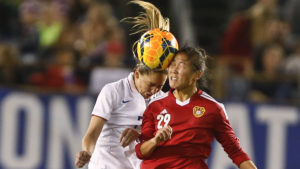May 30, 2023Study suggests headers in soccer not as harmful as originally thought
A new study suggests soccer ‘headers’ may not cause irrevocable harm damage — as long as the technique is properly taught.
The Children’s Hospital of Philadelphia (CHOP) studied the repetitive impacts of headers by athletes using six different tests. The findings suggest that only a small number of headers on throw-in plays did not cause immediate brain problems for teens.

A recent story from USNews.com detailed the study’s findings. Below is an excerpt from the USNews.com story.
“Soccer is a sport where intentionally using your head to hit the ball is an integral part of the game, and concern over its long-term effects has parents, caregivers and coaches understandably concerned,” said study co-author Colin Huber, a postdoctoral research fellow at Emory University in Atlanta. He conducted this research while with the Center for Injury Research and Prevention at CHOP.
“We wanted to simulate these effects in a controlled laboratory setting and build upon the work of prior studies to quantitatively assess the neurophysiological effects of repeated soccer heading,” Huber said in a hospital news release.
In professional sports, repeatedly heading the ball has been linked to long-term brain health issues for some athletes, even without initial symptoms.
Short-term impacts have been poorly understood in youth athletes, but limits have been set. In 2015, the U.S. Soccer Federation limited soccer headers for teens during practice to no more than 30 minutes of header practice time, as well as no more than 15 to 20 headers a week.
In this study, researchers worked with 19 teens (17 boys, 2 girls) aged 13 to 18.
They were assigned to either a frontal heading group, in which they would direct the ball back to where it came from; an oblique heading group, in which they would direct the ball to the right; or a kicking control group.
Participants completed neurophysiological assessments immediately prior to, immediately after and about 24 hours after completing 10 headers or kicks. The assessments included multiple eye movement tracking, pupil response and balance tests.
The study found no neurophysiological issues in either group when compared with the kicking control group.
They did find that oblique headers resulted in higher levels of angular head motion, which is associated with concussions and other brain injuries.
To read the full story from USNews.com, click here.



